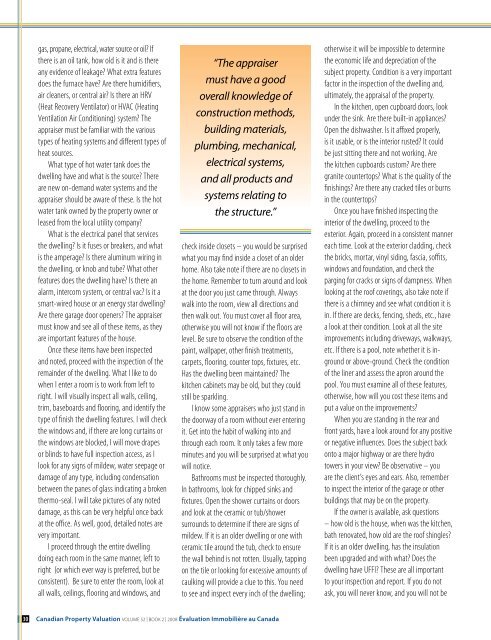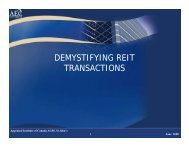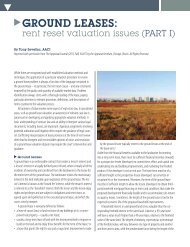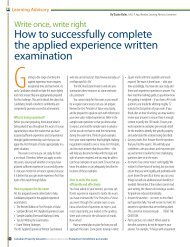Book 2 - Appraisal Institute of Canada
Book 2 - Appraisal Institute of Canada
Book 2 - Appraisal Institute of Canada
Create successful ePaper yourself
Turn your PDF publications into a flip-book with our unique Google optimized e-Paper software.
gas, propane, electrical, water source or oil? If<br />
there is an oil tank, how old is it and is there<br />
any evidence <strong>of</strong> leakage? What extra features<br />
does the furnace have? Are there humidifiers,<br />
air cleaners, or central air? Is there an HRV<br />
(Heat Recovery Ventilator) or HVAC (Heating<br />
Ventilation Air Conditioning) system? The<br />
appraiser must be familiar with the various<br />
types <strong>of</strong> heating systems and different types <strong>of</strong><br />
heat sources.<br />
What type <strong>of</strong> hot water tank does the<br />
dwelling have and what is the source? There<br />
are new on-demand water systems and the<br />
appraiser should be aware <strong>of</strong> these. Is the hot<br />
water tank owned by the property owner or<br />
leased from the local utility company?<br />
What is the electrical panel that services<br />
the dwelling? Is it fuses or breakers, and what<br />
is the amperage? Is there aluminum wiring in<br />
the dwelling, or knob and tube? What other<br />
features does the dwelling have? Is there an<br />
alarm, intercom system, or central vac? Is it a<br />
smart-wired house or an energy star dwelling?<br />
Are there garage door openers? The appraiser<br />
must know and see all <strong>of</strong> these items, as they<br />
are important features <strong>of</strong> the house.<br />
Once these items have been inspected<br />
and noted, proceed with the inspection <strong>of</strong> the<br />
remainder <strong>of</strong> the dwelling. What I like to do<br />
when I enter a room is to work from left to<br />
right. I will visually inspect all walls, ceiling,<br />
trim, baseboards and flooring, and identify the<br />
type <strong>of</strong> finish the dwelling features. I will check<br />
the windows and, if there are long curtains or<br />
the windows are blocked, I will move drapes<br />
or blinds to have full inspection access, as I<br />
look for any signs <strong>of</strong> mildew, water seepage or<br />
damage <strong>of</strong> any type, including condensation<br />
between the panes <strong>of</strong> glass indicating a broken<br />
thermo-seal. I will take pictures <strong>of</strong> any noted<br />
damage, as this can be very helpful once back<br />
at the <strong>of</strong>fice. As well, good, detailed notes are<br />
very important.<br />
I proceed through the entire dwelling<br />
doing each room in the same manner, left to<br />
right (or which ever way is preferred, but be<br />
consistent). Be sure to enter the room, look at<br />
all walls, ceilings, flooring and windows, and<br />
“The appraiser<br />
must have a good<br />
overall knowledge <strong>of</strong><br />
construction methods,<br />
building materials,<br />
plumbing, mechanical,<br />
electrical systems,<br />
and all products and<br />
systems relating to<br />
the structure.”<br />
check inside closets – you would be surprised<br />
what you may find inside a closet <strong>of</strong> an older<br />
home. Also take note if there are no closets in<br />
the home. Remember to turn around and look<br />
at the door you just came through. Always<br />
walk into the room, view all directions and<br />
then walk out. You must cover all floor area,<br />
otherwise you will not know if the floors are<br />
level. Be sure to observe the condition <strong>of</strong> the<br />
paint, wallpaper, other finish treatments,<br />
carpets, flooring, counter tops, fixtures, etc.<br />
Has the dwelling been maintained? The<br />
kitchen cabinets may be old, but they could<br />
still be sparkling.<br />
I know some appraisers who just stand in<br />
the doorway <strong>of</strong> a room without ever entering<br />
it. Get into the habit <strong>of</strong> walking into and<br />
through each room. It only takes a few more<br />
minutes and you will be surprised at what you<br />
will notice.<br />
Bathrooms must be inspected thoroughly.<br />
In bathrooms, look for chipped sinks and<br />
fixtures. Open the shower curtains or doors<br />
and look at the ceramic or tub/shower<br />
surrounds to determine if there are signs <strong>of</strong><br />
mildew. If it is an older dwelling or one with<br />
ceramic tile around the tub, check to ensure<br />
the wall behind is not rotten. Usually, tapping<br />
on the tile or looking for excessive amounts <strong>of</strong><br />
caulking will provide a clue to this. You need<br />
to see and inspect every inch <strong>of</strong> the dwelling;<br />
otherwise it will be impossible to determine<br />
the economic life and depreciation <strong>of</strong> the<br />
subject property. Condition is a very important<br />
factor in the inspection <strong>of</strong> the dwelling and,<br />
ultimately, the appraisal <strong>of</strong> the property.<br />
In the kitchen, open cupboard doors, look<br />
under the sink. Are there built-in appliances?<br />
Open the dishwasher. Is it affixed properly,<br />
is it usable, or is the interior rusted? It could<br />
be just sitting there and not working. Are<br />
the kitchen cupboards custom? Are there<br />
granite countertops? What is the quality <strong>of</strong> the<br />
finishings? Are there any cracked tiles or burns<br />
in the countertops?<br />
Once you have finished inspecting the<br />
interior <strong>of</strong> the dwelling, proceed to the<br />
exterior. Again, proceed in a consistent manner<br />
each time. Look at the exterior cladding, check<br />
the bricks, mortar, vinyl siding, fascia, s<strong>of</strong>fits,<br />
windows and foundation, and check the<br />
parging for cracks or signs <strong>of</strong> dampness. When<br />
looking at the ro<strong>of</strong> coverings, also take note if<br />
there is a chimney and see what condition it is<br />
in. If there are decks, fencing, sheds, etc., have<br />
a look at their condition. Look at all the site<br />
improvements including driveways, walkways,<br />
etc. If there is a pool, note whether it is inground<br />
or above-ground. Check the condition<br />
<strong>of</strong> the liner and assess the apron around the<br />
pool. You must examine all <strong>of</strong> these features,<br />
otherwise, how will you cost these items and<br />
put a value on the improvements?<br />
When you are standing in the rear and<br />
front yards, have a look around for any positive<br />
or negative influences. Does the subject back<br />
onto a major highway or are there hydro<br />
towers in your view? Be observative – you<br />
are the client’s eyes and ears. Also, remember<br />
to inspect the interior <strong>of</strong> the garage or other<br />
buildings that may be on the property.<br />
If the owner is available, ask questions<br />
– how old is the house, when was the kitchen,<br />
bath renovated, how old are the ro<strong>of</strong> shingles?<br />
If it is an older dwelling, has the insulation<br />
been upgraded and with what? Does the<br />
dwelling have UFFI? These are all important<br />
to your inspection and report. If you do not<br />
ask, you will never know, and you will not be<br />
30<br />
Canadian Property Valuation Volume 52 | book 2 | 2008 Évaluation Immobilière au <strong>Canada</strong>

















